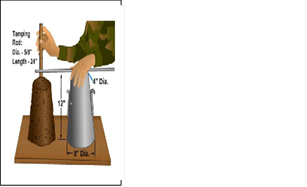| 1. |
The four characteristics of the concrete are: |
|
|
Cement, aggregate, coarse aggregates, and water in proper proportions. |
|
|
Cement, bituminous, lime and water in proper proportions. |
|
|
Cement, small rocks, aggregates. |
| 2. |
The material combined with cement and water to make concrete is called aggregate. Aggregate makes up __________ percent of concrete volume. It increases the strength of concrete, reduces the shrinking tendencies of the cement, and is used as economical filler. |
|
|
60 to 80 |
|
|
10 to 45 |
|
|
30 to 50 |
| 3. |
In Figure 5, a popout happens when: |
|
|
The concrete is struck by a blunt object by accident. |
|
|
When internal pressure causes a small part of the concrete surface to break away |
|
|
It is a normal wear and tear of the concrete |
| 4. |
The two principal functions of water in a concrete mix are: |
|
|
to effect hydration. |
|
|
to improve workability. |
|
|
Both of the above |
| 5. |
In Table 4, one of the formulas for 3,000 psi concrete is 5.80 bags of cement per cubic yard, 233 pounds of sand (per bag of cement), 297 pounds of coarse aggregate (per bag of cement), and a water-cement ratio of 6.75 gallons of water to each bag of cement. These proportions are based on the assumption that the inert ingredients are in a saturated surface dry condition, meaning, |
|
|
that they contain all the water they are capable of absorbing, but no additional free water over and above this amount. |
|
|
they are pressurized to the maximum amount the concrete could stand. |
|
|
the concrete will have the highest tensile strength. |
| 6. |
After measuring the slump measurement, gently tap the side of the mix with the tamping rod. The behavior of the concrete under this treatment is a valuable indication of the cohesiveness, workability, and placeability of the mix. In a well proportioned mix, tapping only causes it to

|
|
|
Slump lower. |
|
|
Crumble apart. |
|
|
Segregate. |
| 7. |
If the concrete crumbles apart, it means it is |
|
|
Oversanded. |
|
|
Undersanded. |
| 8. |
If the concrete segregates, it means it is |
|
|
Oversanded. |
|
|
Undersanded. |
|
|
None of the above. |
| 9. |
There are two reasons to make and test cylinders:
- Determine if the concrete meets the design requirements for specified compressive strength, known as design strength check.
- Determine if the concrete that has been placed is of sufficient strength for the forms to be removed or for the concrete to be put into service, known as construction site control.
|
|
|
True |
|
|
False |
| 10. |
When ready mixed concrete is carried by an ordinary type of carrier, such as a wheelbarrow or buggy, jolting of the carrier increases the natural tendency of the concrete to ___________. Carriers should be equipped with pneumatic tires whenever possible, and the surface over which they travel should be as smooth as possible. |
|
|
Crumble |
|
|
Segregate |
|
|
Slump over |
| 11. |
Most structural concrete is made by placing or casting plastic concrete into spaces enclosed by previously constructed forms. The plastic concrete hardens into the shape outlined by the forms. The size and shape of the formwork is always based on the project plans and specifications. |
|
|
True |
|
|
False |
| 12. |
Concrete is strong under compression, but __________ under tension; the reverse is true for steel. When the two are combined, one makes up for the deficiency of the other. When steel is embedded in concrete in a manner that assists it in carrying imposed loads, the combination is known as reinforced concrete. The steel may consist of welded-wire fabric or expanded metal mesh, but more often, it consists of reinforcing bars, commonly known as rebar. |
|
|
Relatively Weak |
|
|
Steady |
|
|
Relatively Stronger |
| 13. |
one the joints below can control the stress in concrete? |
|
|
Isolation joints |
|
|
Control joints |
|
|
Construction Joints |
|
|
All of the above |
| 14. |
Figure 62 shows |
|
|
How to cure concrete. |
|
|
How to place concrete. |
|
|
How to make concrete. |
| 15. |
Figure 63 shows |
|
|
Using a vibrator to consolidate concrete. |
|
|
Mixing the concrete batch manually at the job site. |
|
|
Adding sand to the mix batch for a more balance mix. |
|